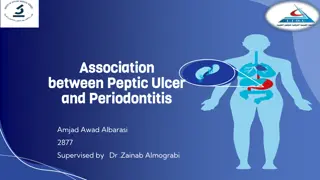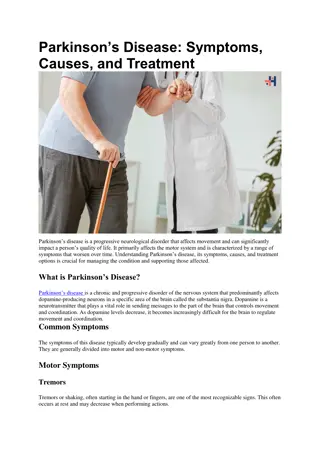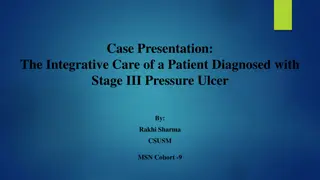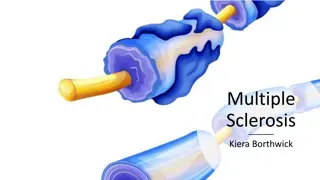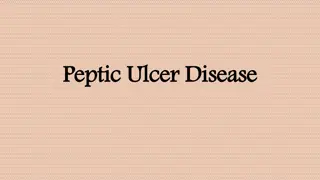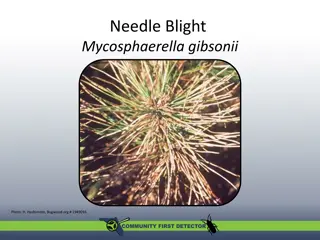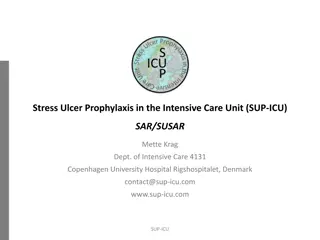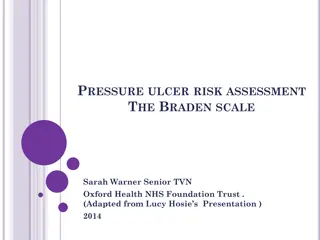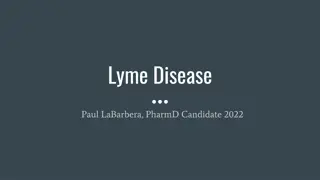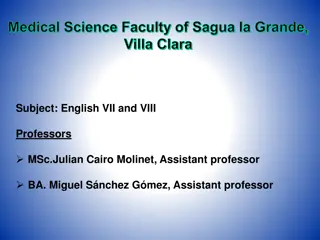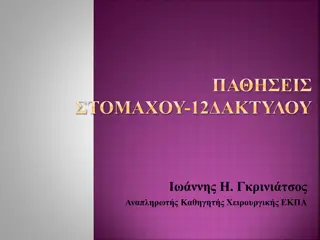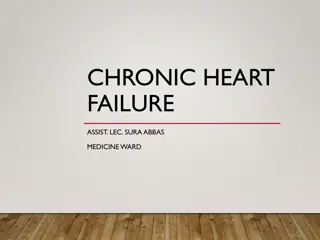Understanding Peptic Ulcer Disease: Causes, Symptoms, and Treatment
Peptic ulcer disease (PUD) involves ulcerations in the duodenal or gastric mucosa caused by factors like Helicobacter pylori infection and NSAID use. Symptoms include abdominal pain and nausea, and treatment often involves H. pylori eradication and proton pump inhibitors to prevent complications like bleeding and gastric cancer.
Download Presentation

Please find below an Image/Link to download the presentation.
The content on the website is provided AS IS for your information and personal use only. It may not be sold, licensed, or shared on other websites without obtaining consent from the author. Download presentation by click this link. If you encounter any issues during the download, it is possible that the publisher has removed the file from their server.
E N D
Presentation Transcript
ODESSA NATIONAL MEDICAL UNIVERSITY UNIVERSITY CLINIC DEPARTMENT of SURGERY #3 PEPTIC ULCER. PERFORATED ULCER. GASTROINTESTINAL BLEEDING
Peptic ulcer disease Peptic ulcer disease (PUD) refers to the full-thickness ulcerations of duodenal or gastric mucosa. The ulcerations form when exposure to acid and digestive enzymes overcomes mucosal defense mechanisms. The most common etiologies include Helicobacter pylori (H. pylori) infection and prolonged use of non-steroidal anti-inflammatory drugs (NSAIDs). Patients may be asymptomatic or may present with abdominal pain, nausea, and early satiety. Peptic ulcer disease typically responds well to medical treatment consisting of H. pylori eradication, eliminating risk factors, and proton pump inhibitors (PPIs). If left untreated, it can lead to bleeding, perforation, gastric outlet obstruction, and gastric cancer.
Introduction Definition A peptic ulcer is a mucosal defect in the wall of the stomach or duodenum that penetrates the muscularis mucosa. Epidemiology Incidence: Uncomplicated peptic ulcer disease (PUD): 1 case per 1,000 person-years in the general population PUD complications: 0.7 cases per 1,000 person-years in the general population Duodenal ulcers > gastric ulcers (3:1) Affects men and women equally Duodenal ulcers occur, on average, 2 decades earlier than gastric ulcers. PUD rates have been falling over the past few decades.
Etiology Infection: Helicobacter pylori or H. pylori (most common): 80% 90% duodenal ulcers 70% 80% gastric ulcers Viruses: Herpes simplex virus (HSV) Cytomegalovirus (CMV) Rare infections: Tuberculosis (TB) Syphilis Mucormycosis Medications: Non-steroidal anti-inflammatory drugs (NSAIDs; most common) Medications linked to PUD or risk exacerbated by combination with NSAIDs: Bisphosphonates Clopidogrel Corticosteroids Spironolactone Chemotherapy Sirolimus Mycophenolate mofetil Potassium chloride
Etiology Hormonal: Gastrinoma (Zollinger-Ellison syndrome) Antral G-cell hyperplasia/hyperfunction (gastritis) Decompensated chronic diseases: Cirrhosis Renal failure Chronic obstructive pulmonary disease (COPD) Prolonged intensive care unit (ICU) stay for any reason Post-surgical: Antral exclusion Gastric bypass Idiopathic Other rare causes: Annular pancreas Sarcoidosis Crohn s disease Radiation Ischemic: cocaine use
Risk factors In many cases, the listed etiologies are not enough to produce PUD. Contributing risk factors to PUD development: Smoking Alcohol Stress (severe illness related, psychologic) Diet Genetic predisposition Blood types A and O
Pathophysiology Anatomic location of ulcers Duodenal ulcer: an ulcer located in the duodenum, typically in the duodenal bulb (1st part) Gastric ulcer: an ulcer in the stomach lining, commonly in the lesser curvature of the stomach near the junction of the fundus and antral mucosa (or type I)
Table: Classification of gastric ulcers by location (modified Johnson classification) Type Location Acid level Lesser curve of the stomach at the incisura angularis I Low to normal Gastric body; coexists with duodenal ulcer II Increased In the pyloric channel (within 3 cm of pylorus) III Increased Proximal gastroesophageal ulcer IV Normal Anywhere in the stomach (aspirin/NSAID induced) V Normal
Pathophysiology Stomach and duodenum: Normally exposed to a toxic environment (acid + pepsin) Imbalance between offending agents and defense mechanisms leads to PUD. Defense preventing mucosal injury: Mucus-bicarbonate-phospholipid layer Epithelial layer (repair of which is regulated by prostaglandins) Subepithelial defense (mucosal blood flow for supply of nutrients and oxygen, disposal of noxious agents)
Pathophysiology Mechanisms by offending agents: Increased gastric acid secretion: H. pylori gastritis or inflammation: gastric acid, inhibits somatostatin, mucus NSAID inhibition of COX 1 prostaglandin ( mucus, mucosal blood flow, epithelial proliferation) NSAID inhibition of COX 2 delays healing Impaired duodenal bicarbonate secretion (in patients with duodenal ulcers) Effects of other etiologies or risk factors: Smoking acid secretion, prostaglandin Zollinger-Ellison syndrome (gastrinoma) gastrin Brain injury increases intracranial pressure, overstimulates vagus nerve gastric acid (Cushing s ulcer) Burn injury (stress) reduced volume, cell necrosis gastric mucosal sloughing impaired barrier (Curling s ulcer)
Clinical Presentation Asymptomatic 70% of PUD patients Older adults Patients taking NSAIDs Complication(s) (bleeding or perforation) may be the 1st clinical presentation without antecedent symptoms.
Clinical Presentation Symptomatic Abdominal pain: Epigastric with radiation to left or right upper quadrants Sometimes radiates to the back Classic duodenal ulcer pain: 2 5 hours after eating and at night (when acid is secreted without food) Sometimes exacerbated by eating (pyloric channel ulcers) Other symptoms: Nausea/vomiting Early satiety Postprandial fullness/bloating Belching
Diagnosis History Review of common risk factors: NSAID/aspirin use Concomitant use of high-risk medications Underlying chronic disease Prior gastric surgery or radiation Laboratory studies Anemia (occult bleeding and/or iron malabsorption) High fasting gastrin levels (if Zollinger-Ellison syndrome is suspected)
Diagnosis Esophagogastroduodenoscopy (EGD) Most accurate diagnostic test Findings: Gastric ulcer: Usually solitary discrete mucosal lesions, with punched-out smooth base Benign lesions have smooth, rounded edges (as opposed to irregular edges noted in malignant lesions). Typically in lesser curvature Duodenal ulcer: Small breaks in the mucosa, often < 1 cm Noted usually in the 1st part of the duodenum
Diagnosis Indications for biopsy: Suspected malignancy (ulcerated mass, irregular margins, abnormal mucosal folds) Any gastric ulcer in areas with a high incidence of gastric cancer If unusual etiology is suspected (e.g., sarcoidosis) Gastric mucosal biopsy of antrum and body (in addition to the ulcer itself) for H. pylori detection
Tests for H. pylori Non-invasive: Stool antigen assay: For initial diagnosis To confirm eradication Urea breath test: Patient is given radioactively labeled urea orally. Urease produced by H. pylori splits urea and liberates CO2. Radioactive CO2is detected in the breath. Serology: Detection of serum IgG against H. pylori Low accuracy IgG remains positive after eradication.
Tests for H. pylori Invasive (require sampling of gastric mucosa): Biopsy urease test: Urease produced by H. pylori liberates ammonia from urea. Alkaline pH changes color of a pH reagent. Histology: Accuracy improved by stains (immunohistochemical, Giemsa stains) Curved, flagellated gram-negative rods are seen. Bacterial culture and sensitivity
Management Risk factor modification Discontinue NSAIDs. Stop smoking, and discontinue intake of alcohol and drugs. Bland diet Medications H. pylori eradication: A combination of an antibiotic regimen and proton pump inhibitors (PPIs): Triple therapy: PPI + clarithromycin + amoxicillin or metronidazole Bismuth-containing quadruple therapy: PPI + bismuth + tetracycline + metronidazole Confirm H. pylori eradication after treatment.
Management PPIs: Uncomplicated ulcers: Given for 2 weeks (plus antibiotic treatment for H. pylori if positive) Longer if the patient has indications for maintenance therapy Complicated ulcers (bleeding, penetration, obstruction, or perforation): Duodenal ulcer: 4 8 weeks Gastric ulcer: 8 12 weeks (confirmation of ulcer healing needed) Longer if the patient has indications for maintenance therapy Maintenance therapy: If NSAIDs or aspirin need to be continued Giant ulcer (> 2 cm) H. pylori negative, NSAID-negative ulcers Recurrent PUD (> 2/year)
Management Repeat endoscopy Duodenal ulcers: Usually not necessary If symptoms persist with treatment > 4 weeks If evidence of ongoing bleeding Gastric ulcers: Persistent symptoms despite 8 12 weeks of medical therapy Unclear etiology Giant ulcer (> 2 cm) Ulcer was suspicious for malignancy on the 1st endoscopy (even with negative biopsy). Evidence of ongoing bleeding Failure to eradicate H. pylori infection Risk factors for gastric cancer: Age > 50 H. pylori Family history Immigrants from endemic areas (Japan, Korea) Gastric atrophy, metaplasia/dysplasia, adenoma
Surgical treatment Uncommon because medical therapy is very effective Indications for surgery: Management of complications: Bleeding Perforation Gastric outlet obstruction PUD refractory to medical management Non-compliance or intolerable side effects of medications
Surgical treatment Surgical principles: Prevent ulcer complications: ulcer resection Reduce acid secretion: vagotomy, antrectomy Minimize postoperative physiologic disturbances: pyloroplasty to facilitate gastric emptying after vagotomy Procedures: Highly selective vagotomy: Only the vagal branches stimulating acid secretion are transected. Vagotomy and drainage (pyloroplasty or gastrojejunostomy) Procedures involving partial stomach resection: Vagotomyand antrectomy: removes the acid-producing portion of the stomach Partial gastrectomy: removes the portion of the stomach containing the gastric ulcer Reconstruction needed for a partial gastrectomy: by gastroduodenal (Billroth I) or gastrojejunal (Billroth II) anastomosis
Complications Gastrointestinal bleeding Patients present with hematemesis and/or melena. May be chronic/low grade and present as anemia Acute bleeding is usually approached with endoscopic intervention. Dieulafoy lesion: vascular malformation in the stomach (submucosa) that ulcerates and causes massive bleeding Surgery may be required if unable to achieve control endoscopically. Perforation Sudden onset of severe diffuse abdominal pain, peritonitis, tachycardia Emergent surgery is required. Penetration Walled-off perforation or perforation into the retroperitoneal space Symptoms not as pronounced as with a free perforation; subacute onset Often results in an abscess formation or fistulas to the surrounding organs (colon, biliary tree, blood vessels)
Complications Gastric outlet obstruction Mechanical obstruction from peri-pyloric inflammation and scarring 1st-line treatment is H. pylori eradication and PPIs. Endoscopic dilation for failure of medical management Surgery as a last resort Gastric cancer Adenocarcinoma MALToma (mucosa-associated lymphoid tissue) Both associated with chronic H. pylori infection and atrophic gastritis
Complications Upper GI bleeding is the most common complication of peptic ulcer disease. The next most common complication is perforation. The annual incidence of upper GI bleeding secondary to a peptic ulcer is estimated to be between 19 to 57 cases per 100,000 individuals. In comparison, ulcer perforation is expected to be 4 to 14 cases per 100,000 individuals. Advanced age is a risk factor as 60% of patients with PUD are older than 60. Infections with Helicobacter pylori and the use of nonsteroidal anti-inflammatory drugs (NSAIDs) are each identified as risk factors for the development of bleeding ulcers and peptic ulcer perforation.
Perforating Ulcer Clinical Presentation Most patients with a perforated peptic ulcer will present with symptoms. The most common symptom in patients with peptic ulcer disease is dyspepsia or upper abdominal pain. This pain may be vague upper abdominal discomfort or it may be localized to either the right upper quadrant, left upper quadrant, or epigastrium. Gastric ulcers may be worsened by food whereas pain from a duodenal ulcer may be delayed 2-5 hours after eating. Patients who are experiencing bleeding from a peptic ulcer may complain of nausea, hematemesis, or melanotic stools. Some patients may report bright red blood per rectum or maroon-colored stool if the upper GI bleeding is brisk. A thorough physical examination should be done on all patients complaining of abdominal pain. Those with a perforated peptic ulcer are likely to have diffuse abdominal tenderness that progresses to guarding and rigidity.
Perforating Ulcer Evaluation The evaluation of a patient in whom perforated peptic ulcer is suspected should be done quickly as the morbidity and mortality increase significantly with time. Even if a perforated peptic ulcer is suspected due to history and physical examination, diagnostic studies should be obtained to confirm the diagnosis and to rule out other possible etiologies. Typical workup includes labs and imaging studies. Standard labs should include complete blood count (CBC), chemistry panel, liver function tests, coagulation profile, and lipase levels (to rule out pancreatitis). Blood type and screening should be done as well.
Perforating Ulcer Evaluation Duodenal perforation can cause acute pain associated with free perforation, or less acute symptoms associated with abscess or fistula formation. Perforation of the duodenum with spillage of intraluminal contents into the peritoneal cavity causes acute chemical peritonitis. This is followed by a systemic inflammatory response syndrome (SIRS), which can progress to secondary bacterial peritonitis and sepsis. Patients with retroperitoneal perforation may lack peritoneal signs and present more indolently. Double-contrast computed tomography (CT) scan is the most valuable method for diagnosing duodenal perforation. It should be performed whenever there is a clinical suspicion and the patient does not need immediate surgery. CT features of perforation include discontinuity of the duodenal wall and the presence of extraluminal air or extravasated oral contrast. Other CT findings include duodenal wall thickening, fat stranding and periduodenal fluid collection.
Management The main goals of treatment are resuscitation, control of infection, nutritional support and restoration of gastrointestinal tract continuity.
Management The main goals of treatment are resuscitation, control of infection, nutritional support and restoration of gastrointestinal tract continuity.
Management Conservative treatment Initial conservative management consists of nil per os, intravenous fluid therapy, broad- spectrum antibiotics, intravenous PPIs, pylori eradication. The added value of somatostatin remains controversial. nasogastric tube insertion and H. Non-operative management of perforated duodenal ulcers is feasible in selected patients. Perforated ulcers may seal spontaneously with fibrin, omentum or by fusion of the duodenum to the underside of the liver between the gallbladder and the falciform ligament. Operative management is usually recommended if there is free leakage of contrast medium into the peritoneal cavity. Progressive abdominal signs or intra-abdominal sepsis should warrant surgery. In high-risk patients, who cannot tolerate surgical treatment, conservative management may also include percutaneous drainage of fluid collections.
Management Endoscopic management Endoscopic treatment is an attractive treatment modality due to its minimally invasive nature. Early endoscopic closure (<24 h) is considered to be technically easier because the inflammatory changes are less pronounced. TTSC Through-the-scope clips (TTSC) can be used for endoscopic closure of small duodenal perforations. Linear perforations <1 cm are most suitable for the use of TTSC. OTSC In contrast to common endoscopic clips, the over-the-scope clips (OTSC) are able to compress larger quantities of tissue. The OTSC technique can be used for perforations ranging from 1 to 3 cm. Endoloop with clips A combined technique using TTSC and an endoloop can be used if the OTSC technique is unavailable. SEMS Self-expandable metal stents (SEMS) are alternative endoscopic treatment options for duodenal perforations.
Management Surgical treatment The choice of surgical treatment depends on the size and localization of the perforation, the viability of the duodenal walls, the degree of local contamination and underlying etiology. Simple surgical repair The main surgical treatment is simple repair of the perforation site. This can be performed as a primary closure with or without the addition of an omental patch. Alternatively, a pedicled omental flap (Cellan Jones repair) or free omental plug (Graham patch) can be sutured into the perforation. Sutureless techniques have also been developed using a gelatin sponge and fibrin glue to seal off the perforation. There seem to be no significant differences in terms of postoperative morbidity and mortality rates when comparing primary closure, omentopexy or tegmentation (without closure). Surgical repair can be performed either with conventional open surgery or with laparoscopy.
Management Surgical treatment Abdominal drains The routine placement of abdominal drains after surgical repair is controversial. The literature suggests no benefit in preventing postoperative fluid collections or abscesses. Furthermore, drains may be associated with increased morbidity such as drain wound site infection. Pyloric exclusion Pyloric exclusion involves surgical repair of the duodenum, gastrotomy and closure of the pylorus from within and finally the formation of a gastrojejunostomy. The rationale behind this procedure is to divert all gastric and biliary secretions from the duodenum. The added benefit of using a gastric diversion procedure such as pyloric exclusion for duodenal perforations has been questioned in recent years. Importantly, the procedure has been associated with more postoperative complications and longer hospital stay compared to simple repair without pyloric exclusion.



